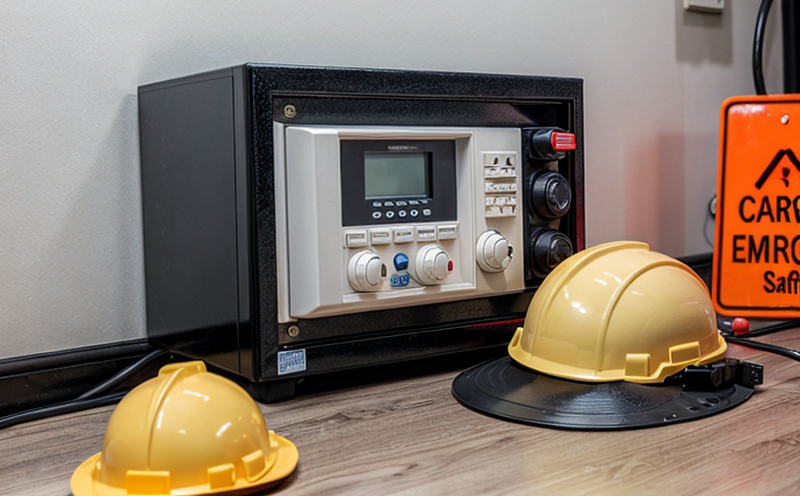ISO 11899 Fixed Fire Suppression System Testing
The ISO 11899 standard provides a comprehensive approach to testing fixed fire suppression systems used in various industrial and commercial environments. This standard is particularly relevant for facilities where the presence of flammable or combustible materials necessitates robust fire protection measures, such as aircraft hangars, fuel depots, and chemical processing plants.
The ISO 11899 series covers different aspects of fixed fire suppression systems, including design, installation, testing, maintenance, and performance evaluation. The standard is designed to ensure that the systems are capable of extinguishing fires effectively while minimizing damage to property and personnel. This service involves a rigorous suite of tests aimed at validating the system's ability to perform under real-world conditions.
The process begins with an initial assessment of the fire suppression system, which includes reviewing design documents, inspecting installation quality, and evaluating compliance with relevant codes and standards like ISO 11899. Once the preliminary checks are complete, the testing phase commences. This typically involves simulating a fire scenario to assess how quickly the system can respond and extinguish the flames.
The testing apparatus used in this process includes specialized fire simulation chambers designed to replicate various fire conditions found in real-world environments. The tests may involve different types of fires such as Class A (ordinary combustibles), B (flammable liquids), C (electrical equipment), or D (metals). Each test is conducted under controlled conditions, ensuring accurate and reliable results.
During the testing process, key parameters are closely monitored to ensure they meet specified thresholds. These include time-to-arrival of extinguishing agents, coverage area, effectiveness in reaching all parts of the protected space, and residual contamination levels after fire suppression. Reporting is meticulous, providing detailed insights into system performance, areas for improvement, and compliance with ISO 11899 requirements.
The testing not only ensures that the system adheres to international standards but also provides valuable data for continuous improvement. This service is crucial in maintaining safety and minimizing risks associated with fire hazards in critical facilities.
Industry Applications
| Application | Description |
|---|---|
| Aircraft Hangars | Ensures the safety of aircraft and personnel during potential fire incidents. |
| Fuel Depots | Prevents catastrophic fires that could lead to explosions or environmental damage. |
| Chemical Processing Plants | Avoids the spread of fires which can cause significant chemical reactions and hazards. |
| Data Centers | Protects sensitive data and infrastructure from fire-related disruptions. |
- Fuel storage facilities
- Petrochemical plants
- Tank farms
- Manufacturing plants with flammable processes
International Acceptance and Recognition
The ISO 11899 standard is widely recognized and accepted across numerous countries, including the United States, Canada, Europe, Asia, and Oceania. This broad acceptance underscores its importance in ensuring consistent safety standards for fire protection systems globally.
Compliance with this standard is crucial for facilities that handle flammable or combustible materials as part of their operations. The widespread adoption of ISO 11899 reflects the growing awareness of fire risks and the need for stringent measures to mitigate them. This service, therefore, not only helps in meeting regulatory requirements but also enhances the reputation of the facility by demonstrating a commitment to safety and compliance.
Many industries rely on this standard as it provides a benchmark against which systems can be evaluated. The use of ISO 11899 ensures that fire suppression systems are tested under controlled conditions, providing reliable data for decision-making processes. This approach helps in identifying potential weaknesses in the system and addressing them proactively.
Competitive Advantage and Market Impact
- Maintains compliance with international standards, ensuring operational safety and regulatory adherence.
- Provides a competitive edge by demonstrating superior fire protection capabilities to clients and stakeholders.
- Enhances the reputation of facilities, attracting more business and investment opportunities.
- Reduces risk exposure through proactive identification of potential issues in the fire suppression system.
The implementation of ISO 11899 testing can significantly impact a facility's market position. By ensuring that all fire protection systems meet stringent international standards, facilities gain a competitive advantage. This is particularly true for industries where safety and compliance are paramount, such as aviation, petrochemicals, and manufacturing.
Furthermore, this service helps in reducing the overall risk of fire incidents, which can have severe consequences for both the environment and human life. By adhering to these standards, facilities can minimize potential disruptions and maintain business continuity, thereby enhancing their operational efficiency and profitability.





